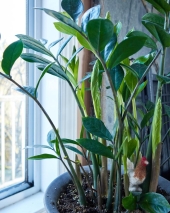
 3
3




 1
1









"You must be the change you want to see in the world." "First they ignore you, then they laugh at you, then they fight you, then you win." --Mahatma Gandhi
"Preach the Gospel always, and if necessary, use words." --Francis of Assisi.
"Family farms work when the whole family works the farm." -- Adam Klaus
 1
1




 1
1




 3
3








Alder Burns wrote:Ordinary black tea (Camellia sinensis) might be less of a stretch....there are varieties hardy at least to zone 7B, whereas coffee is frost-tender I think. Tea tolerates part shade and being a shrub would be a good understory plant in a food forest type system. Remember it is native in a monsoon climate and will want reliable summer moisture (but without waterlogging) to produce well.
Those who hammer their swords into plows will plow for those who don't!
 2
2




 4
4




Yes, I'm that David The Good. My books are here: http://amzn.to/2kYcCKp. My daily site is here http://www.thesurvivalgardener.com and my awesome videos are here https://www.youtube.com/subscription_center?add_user=davidthegood




David Goodman wrote:Wow - awesome.
In TN, I know of a man who was growing lemon trees - no lie - in his backyard. He'd been throwing seeds in the ground for years. They don't even thrive in zone 8, normally... and this was 6a/7b. They were living and growing to multiple feet at the time I was there, but no fruit yet. Awesome.
Those who hammer their swords into plows will plow for those who don't!




Yes, I'm that David The Good. My books are here: http://amzn.to/2kYcCKp. My daily site is here http://www.thesurvivalgardener.com and my awesome videos are here https://www.youtube.com/subscription_center?add_user=davidthegood




Those who hammer their swords into plows will plow for those who don't!




Yes, I'm that David The Good. My books are here: http://amzn.to/2kYcCKp. My daily site is here http://www.thesurvivalgardener.com and my awesome videos are here https://www.youtube.com/subscription_center?add_user=davidthegood












 1
1






 3
3




For growing Arabica coffee beans, there are two optimal growing climates:
The subtropical regions, at high altitudes of 16-24° (Illy, 21). Rainy and dry seasons must be well defined, and altitude must be between 1800-3600 feet. These conditions result in one coffee growing season and one maturation season, usually in the coldest part of autumn. Mexico, Jamaica, the S. Paulo and Minas Gerais regions in Brazil, and Zimbabwe are examples of areas with these climate conditions (Illy, 21).
Climate for Growing Arabica Coffee Beans
Arabica coffee is grown in relatively cool climates in the region between the Tropic of Cancer and Capricorn. The optimum temperature is between 15-24ºC (59-75ºF) year round. Photosynthesis is slowed above these temperatures and frost damage can occur when temperatures hover around 0ºC. Ideally, 1500-2500 mm of rain will fall over a nine month period with a three month dry season coinciding with the harvest (Mitchell, 44). Areas with less rainfall can use irrigation to compensate. A period of moisture stress (rain after a dry spell) helps cause a homogenous flowering and therefore premotes a clearly defined harvesting season. Coffee producing countries with more than one wet and dry season will have more than one harvesting season.
There is a direct relationship between extremes of day and nighttime temperatures and coffee quality. Experimental evidence has indicated that a large gap between day and nighttime temperatures is beneficial to the flavor of fruits. Since a coffee cherry is a fruit and the seed is in contact with the fruit, these benefits will be passed onto the seed and therefore into the cup.
http://kitchengardens.net
http://agrari.us
http://claddaghfarms.com








Medicinal herbs, kitchen herbs, perennial edibles and berries: https://mountainherbs.net/ grown in the Blue Mountains, Australia








 2
2





|
Remember to always leap before you look. But always take the time to smell the tiny ads:
Learn Permaculture through a little hard work
https://wheaton-labs.com/bootcamp
|



